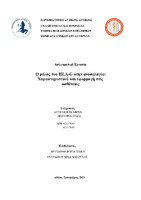| dc.contributor.advisor | Βογιατζάκη, Χρυσάνθη | |
| dc.contributor.advisor | Μιχαλόπουλος, Ευστάθιος | |
| dc.contributor.author | Σκληρού, Αγγελική | |
| dc.contributor.author | Σχίζα, Δέσποινα | |
| dc.date.accessioned | 2021-11-03T11:50:49Z | |
| dc.date.available | 2021-11-03T11:50:49Z | |
| dc.date.issued | 2021-10-08 | |
| dc.identifier.uri | https://polynoe.lib.uniwa.gr/xmlui/handle/11400/1478 | |
| dc.identifier.uri | http://dx.doi.org/10.26265/polynoe-1329 | |
| dc.description.abstract | Το ανθρώπινο λευκοκυτταρικό αντιγόνο G (HLA-G) ανήκει στα μη κλασσικά μόρια του μείζονος συμπλέγματος ιστοσυμβατότητας G (MHC) τάξης Ι (Ib) και αποτελεί ανοσοκατασταλτικό μόριο με 4 μεμβρανικές (HLA-G1, -G2, -G3, -G4) και 3 διαλυτές (HLA-G5, -G6, -G7) ισομορφές που προκύπτουν από το εναλλακτικό μηχανισμό ωρίμανσης του mRNA. Το μόριο αυτό βρίσκεται σε ελάχιστα ποσοστά σε υγιή άτομα κάτω από φυσιολογικές συνθήκες. Επίσης, φαίνεται να παίζει ρόλο στην ρύθμιση της ανοσίας σε νεοπλαστικές, αυτοάνοσες και φλεγμονώδεις καταστάσεις και σε επιπλοκές της εγκυμοσύνης και των μεταμοσχεύσεων στις
οποίες εκφράζεται από τα κύτταρα της ανοσίας, υποστηρίζοντας ότι μπορεί να έχει ρόλο στην παθογένεση αυτών των διαταραχών. Στην παρούσα ανασκόπηση, πραγματοποιήθηκε χαρακτηρισμός των δομικών και λειτουργικών χαρακτηριστικών του HLA-G. Επίσης, έγινε αναφορά των μηχανισμών αλληλεπίδρασης του HLA-G καθώς και των ισομορφών του με το
ανοσοποιητικό σύστημα σε διάφορες παθολογικές και μη καταστάσεις. | el |
| dc.format.extent | 144 | el |
| dc.language.iso | el | el |
| dc.publisher | Πανεπιστήμιο Δυτικής Αττικής | el |
| dc.rights | Αναφορά Δημιουργού - Μη Εμπορική Χρήση - Παρόμοια Διανομή 4.0 Διεθνές | * |
| dc.rights | Attribution-NonCommercial-NoDerivatives 4.0 Διεθνές | * |
| dc.rights.uri | http://creativecommons.org/licenses/by-nc-nd/4.0/ | * |
| dc.subject | HLA-G | el |
| dc.subject | HLA | el |
| dc.subject | MHC | el |
| dc.subject | Ανοσολογία | el |
| dc.title | Ο ρόλος του HLA-G στην ανοσολογία: Χαρακτηριστικά και εφαρμογή στις ασθένειες | el |
| dc.title.alternative | The role of HLA-G in immunology: Characteristics and application in diseases | el |
| dc.type | Πτυχιακή εργασία | el |
| dc.contributor.committee | Βογιατζάκη, Χρυσάνθη | |
| dc.contributor.committee | Χανιώτης, Δημήτριος | |
| dc.contributor.committee | Μιχαλόπουλος, Ευστάθιος | |
| dc.contributor.committee | Kriebardis, Anastasios | |
| dc.contributor.faculty | Σχολή Επιστημών Υγείας & Πρόνοιας | el |
| dc.contributor.department | Τμήμα Βιοϊατρικών Επιστημών | el |
| dc.description.abstracttranslated | Human Leykocyte Antigen G (HLA – G) is part of non classical class I molecules of the major histocompatibility complex (MHC). It’s an immunosuppressive molecule consisting of 4 membrane – bound (HLA – G1, – G2, - G3, - G4, - G5, - G6, - G7) isoforms, which are the result of alternative splicing. This particular molecule has been described to play a role in immunoregulation after having been identified in neoplastic, autoimmune and inflammatory conditions and pregnancy and transplantation complications, where it’s expressed by immune cells, while very low levels of it exist in physiological conditions, supporting the claim that it might play a role in the pathogenesis of these disorders. In this review, we go over the structural and functional of the molecule and the ways that it interacts with the immune system, studying how it can act under pathological conditions. | el |


